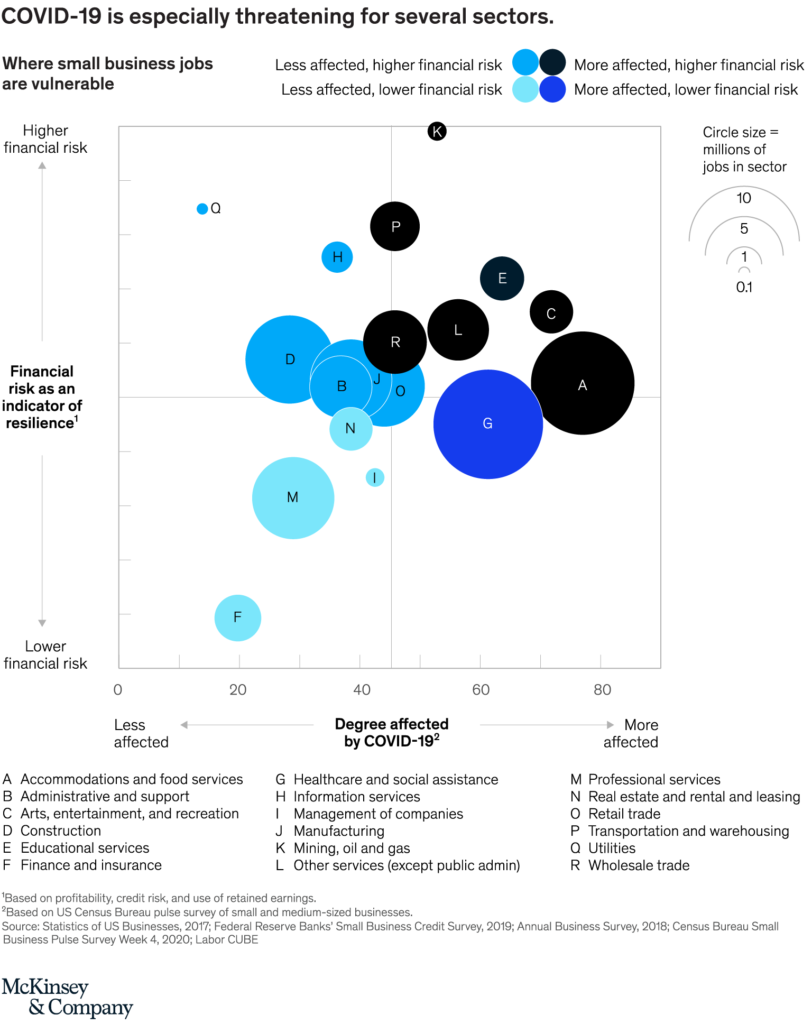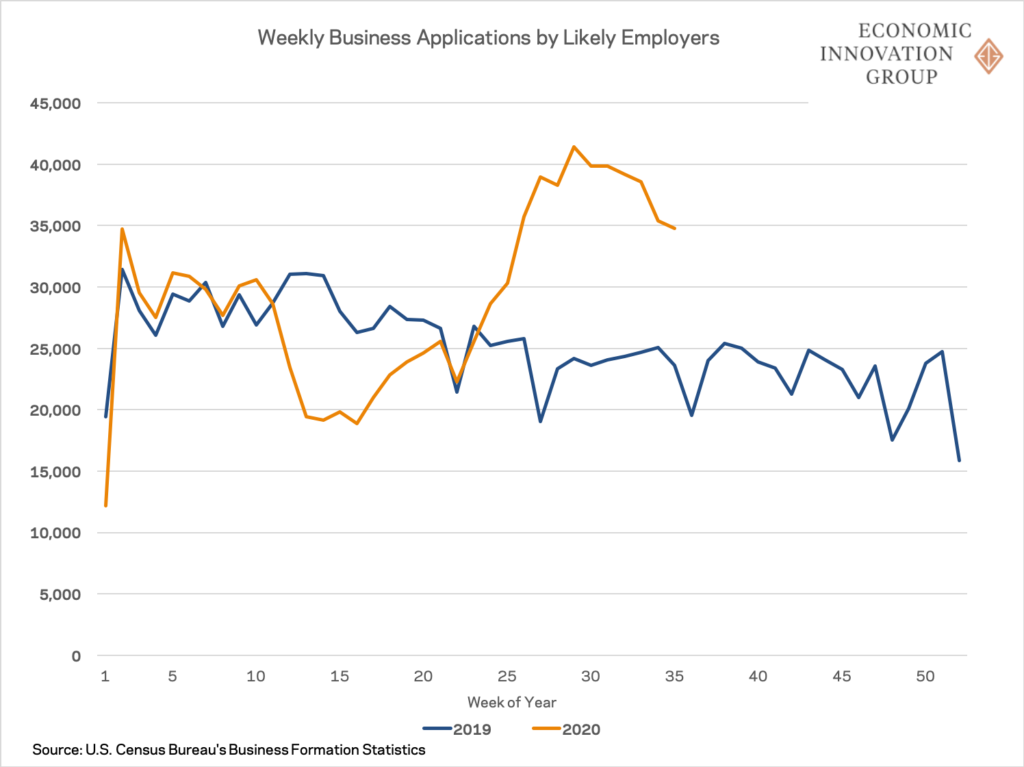The SARS-CoV-2 pandemic has upended the way the world conducts business.
From social distancing guidelines, to limited store capacities, to the regular usage of face masks in public, changes have been made to ensure the safety of people everywhere.
All of this is new, confusing, and a little scary. This is especially true if you’re a business owner whose livelihood is now at the precipice of struggle. You need to keep your business running while making sure that you, your employees, and your customers are protected from the virus.
And if you’re thinking of starting a business now, you want to make sure that you can do so safely while juggling the hundreds of new tasks that come with it. Launching and running a business is hard enough in the best of times—it can seem downright daunting during a global pandemic
That’s why we want to help.
Whether you’re thinking of starting a new business or already in the thick of running one, this guide breaks down everything a small business owner needs to know in order to navigate COVID-19 safely and successfully.
What we’ll go over
Here are some jump links to the sections of the article. Each section covers a different topic, so feel free to jump around to the topic you want to learn more about.
By-the-numbers: How are small businesses doing overall?
How to navigate your small business through COVID-19
How to prep your business for COVID-19
Pandemic resources for small businesses
Pro tip: Bookmark this guide so you’ll have it handy when you need to refer to it.
By-the-numbers: How are small businesses doing overall?
Quick answer: Not great.
The massive impact on small business that the global pandemic and subsequent lockdown procedures have had cannot be overstated. For the vast majority of them, that impact has been resoundingly negative, resulting in layoffs and store closures across the world.
In the United States alone, 25% to 36% of small businesses are at risk of permanently closing due to COVID-19. Many of these businesses rely heavily on in-person services where social distancing is difficult to maintain, such as restaurants and gyms. Other industries heavily impacted include tourism and hospitality.
Here’s a graph from McKinsey that illustrates the industries impacted the most by COVID-19:

Source: McKinsey and Company
Small business income is down 12.3% from February 2020, whereas private industry salaries are down “just” 6.6%. That’s nearly twice as much as their private industry counterparts.
It’s also crucial to note that there is a disproportionate impact on marginalized communities. In fact, low wage workers, minority business owners, and those without a college degree are much more likely to experience financial strain due to the global pandemic.

Source: McKinsey and Company
While this looks rather dire, it should be noted that things are getting better, albeit slowly. In June 2020, the Census Bureau discovered that the number of small businesses reporting a negative impact from COVID-19 was at 38%—down from 51% two months earlier in April.
Applications received for new businesses have also jumped since the height of the global pandemic in the spring.
In fact, by the end of August 2020, the United States saw a 47% rise in business applications when compared to the same week in 2019, reaching a historic high point.

Source: Economic Innovation Group
This should be incredibly heartening to any small-business owner. When a vaccine is readily available (and all evidence points to a historically fast vaccine production), the economy will be primed for massive growth.
Think of the economy as a fleet of airplanes. When the weather is bad—winds blowing hard, thunderstorms raging—the pilots can’t fly. Instead of letting the airplane rust while they all wait for the weather to get better, though, the pilots are going to make sure there’s plenty of fuel in the tanks, the engines are running smoothly, and that the electronics are working.
Once the weather clears, they’ll all be ready for take off.
How to navigate your small business through COVID-19
If you own a small business, you’ve undoubtedly experienced the pandemic’s effect on you, your customers, and your bottom line.
You’ve also had to make changes—some large and some small. All of these changes can be confusing and scary.
To help make it a little less complicated, here are a few tips to keep in mind to help guide your business through this bad weather.
Tip #1: Focus on what you can control (and forget all the rest)
This is one of the most crucial things you can do mentally. And it not only applies to the pandemic, it applies to the rest of your life as well.
It’s easy to get caught up in the constant firehose spray of bad news, doomscrolling until our eyes tire. There are so many things you feel like you need to be worried about that it can be overwhelming.
Instead, you should focus on the things that you can directly control. That might include things like:
- Sanitation and hygiene procedures for your store
- Switching to remote work
- Increasing your digital marketing strategy
- Getting loans when you can
- Employing curbside pickup
- Conducting home deliveries for customers
What that doesn’t include are things like:
- Obsessing about lockdown procedures
- Obsessing about lessened customer capacity limits in your store
- Obsessing about mask mandates
- Obsessing about rising COVID-19 case counts
Actually, obsessing over anything really is bad. While things like lockdown procedures and rising cases will impact your business, you should take that news into consideration and then focus on how you can respond to it.
Of course, that’s easier said than done. This is your livelihood after all. And if you have employees, this is their livelihood as well.
By adopting this mindset, you’ll not only be able to help your business adapt to the changing time but you’ll find that it will take you much further than any amount of doomscrolling will.
Tip #2: Move quickly—but carefully
The early bird gets the worm. That tried-and-true aphorism applies to this life-altering global pandemic.
It is crucial to recognize the areas where you have to adapt, and then do so quickly. For example, many businesses—from grocery stores and clothing shops to coffee shops and breweries—began to offer curbside pickup when lockdown procedures were implemented in spring 2020.
In fact, curbside and delivery saw a 145.6% surge in the spring when compared to the same period in 2019.

Source: Brick Meets Click
These businesses recognized the inevitable changes because of COVID-19, adapted, and are now making money because of it.
No, many of them are likely not making as much money as they were before. But some of them are even seeing that their “new reality” is better than what they were doing.
In fact, many companies are finding that remote work is better suited for their operations than coming into an office. Other businesses are finding great success with curbside pickup and deliveries. There’s even evidence that consumer habits are forever changed by these events.
While you should take necessary steps to adapt your business to the changing climate, you should also take care to make the right kinds of adaptations.
You don’t want to do something like buy a bunch of state-of-the-art sanitation and air filtration systems only for your business to be closed anyway due to lockdown measures.
Tip #3: Make the touch choices
Firing or furloughing employees is never easy and it shouldn’t ever be easy. These are the people who keep your business running—they depend on you for their livelihood and, in many cases, they can be your very good friends.
However, when it comes to extraordinary circumstances like a global pandemic, sometimes you need to make the incredibly hard decision to let them go or furlough them to keep your business afloat.
That might mean different things for different businesses. For example, you might discover that you are able to keep some employees on after looking at your numbers. Some of you might need to make the tough decision to fire a lot of people.
The important thing is that you recognize what you need to do and follow through. There’s no use dragging it out and hoping things will change. In all likelihood, that change won’t come until there’s a vaccine. Focus on what you can control now and ignore the rest.
Tough decisions also might involve taking stock of your business as a whole and deciding whether or not to keep it going. That might seem inconceivable. After all, you put your heart and soul into your business.
But, once again, it’s important to be honest with yourself and not drag it on. Not taking earnest stock of the situation might result in even bigger financial problems for you later on.
Tip #4: Enforce hygiene standards (and be strict about it)
This one is non-negotiable. No matter where you are or what business you conduct, you need to enforce hygiene standards—and they need to be strictly enforced.
This pandemic has killed hundreds of thousands of people in the United States alone. You don’t want your business to be the reason that anyone dies or is infirmed. You definitely don’t want your business to start making headlines because it resulted in a super-spreader event.
That’s why it’s imperative to create a COVID-19 policy for your business.
This is going to be specific to you and your business, and will depend on what services you provide. Restaurants need to have different policies than an accountant’s office, after all. You’re also going to need to take into account the regional restrictions your business will have.
Here’s a handy chart that gives you a rough idea of what occupations are most at risk for COVID-19.

Source: Visual Capitalist
Remember: This is only a rough idea. That means what you ultimately need to do will be tailored to your business.
Our biggest piece of advice would be to stray on the side of overpreparing rather than the alternative. It might mean slowing down your work processes to make sure everything and everyone is sanitized—but it’s worth it if it means keeping you and your community safe.
To that end, we’ve prepared something to help…
How to prep your business for COVID-19
The Center for Disease Control has prepared a set of guidelines to prevent and reduce the transmission of COVID-19 among your employees. It is quite long, so we’ve summarized the big points for you below.
However, we highly recommend you read through the entire page yourself in order to get a deep understanding of what you need to ensure your business’s safety.
Keeping your employees safe
Your employees are the backbone of your business. Without them, your business wouldn’t run the way it should.
They’re also people who deserve to be safe and healthy even outside of your business.
That’s why it’s so important that you enforce strict standards to reduce the risk of transmission amongst them. The CDC recommends seven things to help keep your employees safe:
- Tell sick employees to stay home. This one is a no-brainer. If your employee has a fever, coughing, or showcasing other signs of sickness, tell them to stay home. The recommendation is generally to quarantine for 2 weeks after they last showed symptoms.
- Conduct daily health checks. This can occur in-person or remotely. These health checks should include symptom and/or temperature checks before any worker shows up to your physical place of business.
- Identify how employees might get exposed to COVID-19 at work. Consider all of the locations at your workplace where an employee might contract the disease. For example, a grocery store might identify places like the cash register or customer support line as high-risk areas.
- Enforce face mask policies. This is another no-brainer. Your employees should be wearing face masks for their own protection and the protection of everyone else at your place of business (including customers).
- Separate sick employees. You never know when symptoms are going to hit. As soon as they do, you want to act fast. If an employee starts to exhibit symptoms while at work, quarantine them from other workers and customers. Also have a way they can get home safely. This can be through another employee or a healthcare worker.
- Take action if you find out an employee has COVID-19. Though in most cases you won’t have to shut down your business (for example, if it’s been more than a week since the sick employee has been in the facility), it is recommended that you wait 24 hours before cleaning and sanitizing your place of work. Clean any areas frequently exposed to people, as well as where the sick employee worked.
- Implement a sanitation policy for your employees. Make sure your employees are aware of the best ways to protect themselves against getting sick. That includes washing their hands, wearing masks, and limiting travel.
Keeping your business sustainable
As a business owner, you’ll want to balance the importance of keeping everyone safe while keeping your business running smoothly and effectively. The CDC has identified a number of areas to help you do just that:
- Choose a COVID-19 coordinator. This person is responsible for implementing and creating any COVID-19 policies specific to your business. It is a position you can delegate to one of your employees or take on yourself.
- Have a flexible and supportive sick leave policy. Make sure you provide your sick employees as much support as you can give them. This might include policies such as paid sick leave, permitting them to stay at home to care for sick family, or allowing other employees to donate sick leave to one another.
- Protect high-risk employees. Immunocompromised and older employees should be supported during this time. That might include minimizing their contact with customers or allowing them to work remotely.
- Communicate the new COVID-19 policies clearly and frequently. If your employees speak another language, make sure that your policies are translated for them. Also let new customers/employees know about your safety policies.
- Keep the essentials and cut the rest. In order to maintain safe practices, consider paring down your employees to a skeleton crew of the people who absolutely need to be there for your business to keep running. This might mean making tough decisions like cutting back hours, furloughing, or letting go of certain employees.
- Plan for if/when absenteeism rises. Whether it’s from sick employees or because your employees don’t want to come in, you need to be prepared in case absenteeism spikes in your workplace. This includes implementing remote work policies or training employees to handle additional responsibilities.
- Implement social distancing policies. These are social distancing policies for both your employees and customers. Restrict physical interaction between people (e.g. handshakes). Also, limit areas where people tend to congregate (e.g. break rooms or dining tables).
Keeping your workplace safe
The CDC also provides guidelines for ensuring the physical workplace of your small business is optimized for safety against COVID-19. Below are a few tips they highly suggest you implement:
- Improve your workplace’s ventilation. This refers to the amount of fresh air that is circulated throughout your workplace. The more fresh air there is, the better protected you’ll be against COVID-19 as it is primarily spread through air droplets. Some suggestions to do this include increasing outdoor air ventilation through open windows and improving air filtration with a MERV-13 filter on your central air system.
- Make sure your water system is safe after shutdown. After a prolonged shutdown, a building’s water system is more susceptible to hazards such as mold and Legionnaires’ disease. Find out how to keep your water system in check here.
- Provide access to washing and sanitizing equipment. Make sure your business has plenty of access to soap and water, as well as alcohol-based hand sanitizers.
- Clean your workplace often. Make sure that you frequently sanitize your workspaces and provide easy access to cleaning supplies such as disinfectant wipes. The CDC offers a full guide on how to create and maintain a regular cleaning plan.
- Sanitize your workplace when someone is suspected or confirmed of having COVID-19 has been there. This includes employees as well as customers.
- Restrict travel amongst employees. Cut out any non-essential travel for your employees. If employees are traveling abroad, make sure they check the CDC’s Traveler’s Health Notices for guidance about the country they’re traveling to.
- Limit risks when planning meetings. Leverage good video conferencing tools rather than holding in-person meetings with your employees. If your business regularly plans large gatherings (e.g. conferences), you’ll want to cancel or reschedule them accordingly. You might also want to adapt them so they’re mostly or all virtual.
Pandemic resources for small businesses
Below is a list of resources from the CDC that you should have handy. They’ll help you answer any questions you might have about running a small business during the pandemic.
Conclusion
Managing your small business in the middle of a global pandemic is no small task. It requires a combination of resilience, focus, and discipline to make sure that your employees and customers are adhering to the strict standards in place to keep us all safe.
We won’t lie to you: It’s going to get hard. You’re likely going to see your profits tighten. You might even have to make difficult decisions to let go of employees.
But remember to focus on the things you can control and ignore all the rest. That means creating and enforcing sanitation and hygiene policies while maintaining social distancing. Also, support your employees financially and mentally when you can.
That’s because the most important thing at the end of the day is everyone’s health and well-being. With the right resources and systems in place, we’ll all be able to get through this challenge together—and hopefully, stronger for it.













